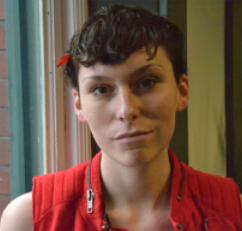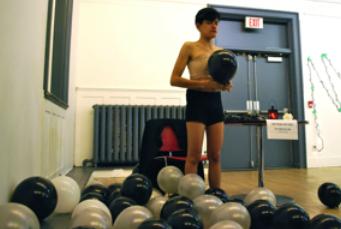
Morgan Page wants activists to tackle poverty and immigration issues as well as transphobia. Credit: Andrea Houston
“My name is Tyra Trent,” read speaker Luka Sidaravicius.
“I was asphyxiated on Feb 19, 2011, in Baltimore in the United States in a vacant, city-owned house. I was 25 years old.”
Sidaravicius was one of more than 175 people who gathered at the 519 Church St Community Centre on Nov 18 to mourn the hundreds of trans people, including Tyra Trent, who are killed worldwide each year.
The event was held as part of the International Trans Day of Remembrance on Nov 20.
Between November 2010 and November 2011, 221 trans people were murdered. Of those killed — many brutally and violently — most were from Latin America or Asia. Nine were from the United States; none were Canadian.
“I believe that to honour the dead we must fully try to understand the circumstances that led to their deaths,” said Morgan M Page, trans community services coordinator at The 519.
Page called on activists to do more than fight transphobia alone. She says poverty and harsh immigration policies allow global transphobic violence to continue.
“If we in Canada want to make a difference in the lives of those people in the countries affected most, we have to do what we can here to actually improve conditions there,” she said.
Page says she wants activists to fight for reforms to Canada’s immigration laws so trans and queer people fleeing violence abroad can find safety in Canada.
Sidaravicius, originally from Brazil (where 97 of the 221 deaths took place), says, “I think it’s very easy to get in a state of mind where we think that trans people only exist in North America.
“In reality, most of the trans people who have died are not North American . . . It’s important to remember our privileges as well as our oppression.”
Simone Santos Rodriguez, a sex worker in Baha, Brazil, was stabbed at least 17 times in her own apartment, according to Transgender Europe’s Trans Murder Monitoring project.
Many trans people are abused and often murdered by police and public authorities.
In another Brazilian case, Mica, 22, of Umarizal, was shot twice in a public square while out with friends. Friends say Mica made a joke as military police drove past in their car. A police officer then threatened her, and 20 minutes later two men on a motorcycle drove to the square and shot her.
Friends and relatives say Mica was often subjected to ridicule and intimate body searches by police.
Almost a fifth of those killed worldwide were sex workers; many were murdered by clients.
“There’s a disproportionate number of trans people involved in sex work and . . . the majority of trans people are incarcerated for sex-work-related offences,” says Page.
She points to the high cost of surgery and hormones, as well as employment and housing discrimination, as factors that can result in trans women choosing sex work.
“It’s often easier or perhaps the only possible option . . . to rely on sex work for their income,” she says. “We have to see the struggle for trans rights as being inextricably bound up with sex workers’ rights.”


 Why you can trust Xtra
Why you can trust Xtra


